Applications of Montage - Scientific Product Generation
Our customers have exploited the capabilities of Montage in generating scientific products, underpinning quality assurance of data products, deploying data access services, analyzing data, and in deriving educational and public outreach products.
The Spitzer Space Telescope supports Science Legacy programs, whose data products are considered of exceptional long-term value to astronomy. Three of these projects, the Spitzer Wide-area Infrared Extragalactic Survey (SWIRE) (Lonsdale et al. 2003), the Galactic Legacy Infrared Mid-Plane Survey Extraordinaire (GLIMPSE) (Benjamin et al 2003), and Surveying the Agents of a Galaxy's Evolution (SAGE) (Meixner et al 2006) have incorporated Montage into their data processing pipelines. These pipelines are generating scientific data products that are being made publicly accessible through the NASA/IPAC Infrared Science Archive (IRSA) and the Spitzer Space Telescope Archive.
SWIRE has imaged 49 square degrees of the sky (equivalent to the area covered by about 250 full moons), covering six different regions. The SWIRE Spitzer data products have been measured with the Infrared Array Camera (IRAC) (3.6, 4.5, 5.8 and 8.0 µm) and the Multiband Imaging Photometer (MIPS) (24, 70 and 160 Ám), supported by optical ancillary data for selected regions. (Lonsdale et al. 2003). The optical data in most cases are in the u, g, b, r, i, z bands and originate either from the 2.5m Isaac Newton Telescope (INT) in La Palma, KPNO, or CTIO. These ancillary data come from different telescopes, have different resolutions, orientation, projections and are in a variety of file formats, and so significant effort is put towards converting these data to a uniform base set, which makes data analysis much easier for the SWIRE team and for the public. Montage has been incorporated into the SWIRE processing system to mass-process thousands of optical observations to a common set of image parameters with the Spitzer observations; these parameters are projection, orientation coordinate system, spatial sampling and tiling scheme. The optical and Spitzer data are then fed into multi-band visualization tools to find new sources across the optical, near infrared and infrared wavelength bands.
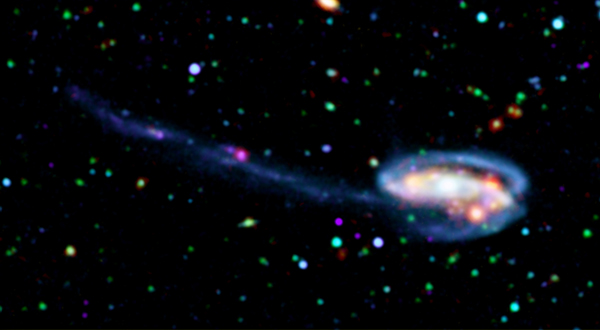
Optical-infrared panchromatic view of the Tadpole Galaxy (UGC10214), the result of a galaxy-galaxy interaction that has stretched the outer spiral arm into a long tadpole-like tail. The image is a composite combination of eight SWIRE bands (ordered from blue to red colors): U-band (0.348 µm), g-band (0.485 µm), r-band (0.624 µm), i-band (0.774 µm), IRAC-1 (3.6 µm), IRAC-2 (4.5 µm), IRAC-4 (8.0 µm) and MIPS-1 (24 µm). Image by Dr. Tom Jarrett and the SWIRE team.
GLIMPSE (actually two complementary surveys, GLIMPSE I and II) is providing the first global survey of star formation in the Galaxy through a survey of the Galactic plane at wavelengths of 3.6, 4.5, 5.8, and 8.0 µm with the Infrared Array Camera (IRAC) aboard Spitzer. It is a fully sampled, confusion limited, 4-band near- to mid-infrared survey of the inner two-thirds of the Galactic disk with a spatial resolution of ~2" in the Galactic longitude range of 65 . GLIMPSE has integrated Montage into its processing environment, a cluster of Linux machines, to deliver an Atlas of image mosaics for each band, each covering 1.1 x 0.8 degrees.
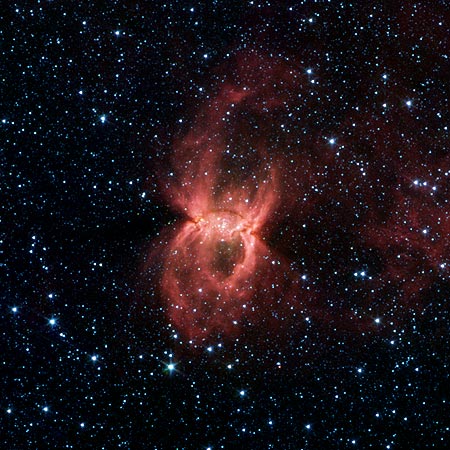
Four-channel false-color composite of the Black Widow Nebula in the Circinus constellation: 3.6 µm (blue), 4.5 µm (green), 5.8 µm (orange) and 8.0 µm (red). Credit: NASA/JPL-Caltech/E.Churchwell (Univ. of Wisconsin)
SAGE is performing an unbiased survey imaging survey of approximately 49 square degrees of the Large Magellanic Cloud (LMC). It is surveying the interstellar medium and stellar content with the IRAC (3.6, 4.5, 5.8 and 8 µm) and Multiband Imaging Photometer for Spitzer (MIPS) (24, 70, and 160 µm) instruments on board the Spitzer Space Telescope (Spitzer) in order to trace the lifecycle of observable material in the LMC (Meixner et al. 2006). IRAC and MIPS have very different footprints on the sky, and so SAGE has integrated Montage into their processing pipeline to generate co-registered mosaics from 3.6 µm to 160 µm. Below is a mosaic of the LMC produced by the SAGE pipeline that aggregates 300,000 frames of IRAC and MIPS data.
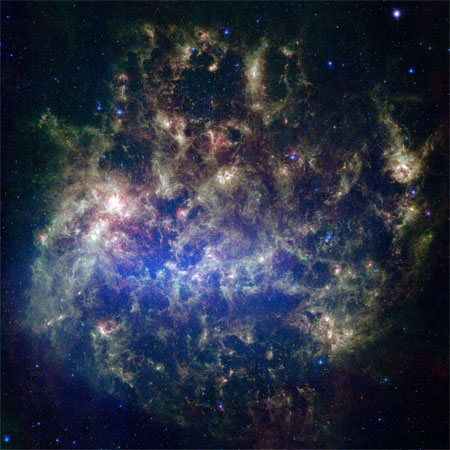
Composite 7.4 deg x 7.4 deg image of the Large Magellanic Cloud (LMC) assembled from over 300,000 frames measured with the Spitzer Space Telescope: using the Infrared Array Camera (IRAC) at wavelengths of 3.6 (blue) and 8 (green) microns; and the Multiband Imaging Photometer for Spitzer (MIPS) at 24 microns. SAGE incorporated Montage into their pipeline to generatea this image. Credit: NASA/JPL-Caltech/M.Meixner (STScI) & the SAGE Legacy Team
The Isaac Newton Telescope (INT) Photometric H-alpha Survey of the Northern Galactic Plane (IPHAS) is surveying the entire northern galactic plane (Drew et al. 2005). It is providing a census of emission line objects and extended interstellar emission in the Galactic plane. Montage is used to generate mosaics of emission line nebulae that discriminate nebular emission from background reflection and emission, and thereby permit the interaction of extreme phases of stellar evolution with the interstellar medium. Drew et al. note that, although extended emission on scales of 1 degree or more may be confused with atmospheric emission, the mosaics bring out more subtle detail than has previously been possible. The mosaic below shows a 5 x 3.5 of the supernova remnant S147.
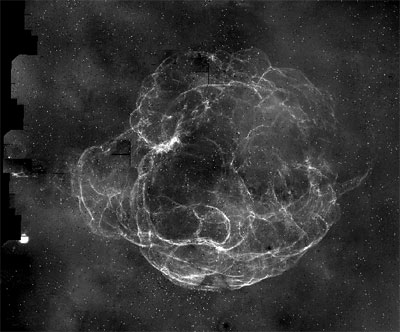
This is a continuum-subtracted H-alpha image mosaic of the supernova remnant S147, constructed using Montage. The total imaged area is roughly 5 x 3.5 square degrees. The bright "blob" to the left of the picture is a more typically compact Galactic nebula. Credit: Albert Zijlstra, University of Manchester; Jonathan Irwin, IoA Cambridge
The MultiMission Archive at Space Telescope Science Institute (MAST) and the NASA Star and Exoplanet Database (NStED), have generated quick look, thumbnail image mosaics of 2MASS images centered on several thousand targets. The mosaics were generated in FITS format with the Montage core modules, and then converted to JPEG format with mJPEG. At MAST, the JPEG images are included in the return pages of a Spectral/Image Scrapbook that returns, for a target source, thumbnails of observations archived at MAST. NStED will, when complete, provide a single interface for finding the most up to date measurements of nearby stars, to support selection of targets for planet finding missions. The data returned include "finding charts," which include overlays of proper motion, for the 1,00 or so "best candidates."
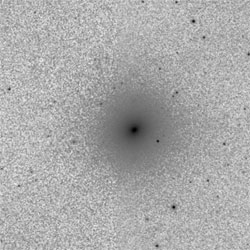
From MAST: M84 (NGC 4374), Lenticular (S0) Galaxy in Virgo. One of the 2MASS J-band mosaics for each Scrapbook region, 20x20 arcmin in size, 1 arcsec resolution, with projection centered on the Scrapbook location and Equatorial J2000 North up.
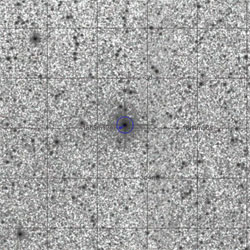
NStED is an archive and search facility for nearby stars (used in part for planet-finding efforts). NStED has used Montage to generate small 2MASS mosaics around each of their stars with overlays showing proper motion (which can be quite large for many of these objects). Shown is the source HIP 088574, which is about 8 parsecs away and has a proper motion of about 11 arcminutes/year.
The US Virtual Astronomical Observatory (US VAO) has taken advantage of MPI to develop science products for distribution to astronomers. Grist is a data-mining project that aims to develop grid techniques for federating wide-area image data sets, mainly using the TeraGrid. Montage is an integral part of the image federation toolkit. It is used primarily as a re-projection engine within Atlasmaker, a grid-based workflow manager, to federate images with diverse properties into an atlas of images having a common scale, organized for efficient storage and fast access.
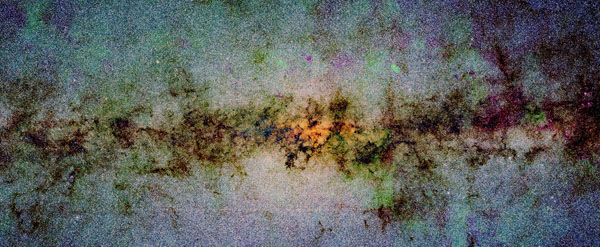
Thumbnail of a color composite of large scale mosaics of the 2MASS J, H, and K image data at full resolution (1 arcsecond/pixel). The entire image covers 44x8 degrees of the Galactic plane, centered on the Galactic center (158,400 x 28,800 pixels; 109.5 GBytes). If printed out, it would be eight feet high. Click for a larger version.
A second VAO science product is the generation of an all-sky 2MASS image mosaic, which will add value to the 2MASS image data set curated by IRSA in these ways in combining overlapping images to improve sensitivity (Laity et al. 2006). To date, the entire 3-color image collection has been aggregated into a single mosaic on the TeraGrid node at San Diego Supercomputer Center (SDSC) . A total of 4,121,440 files in the J, H and Ks bands in the Gnomonic SIN projection, each 2 MB in size (32-bit), have been processed into three mosaics 20-TB in total size in TAN projection (64-bit). They are organized for storage into 1,734 6-degree plates, each 2-GB in size. A second processing pass will include unpublished 2MASS survey data, and this mosaic is scheduled for public distribution.

